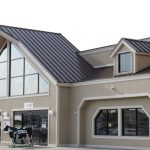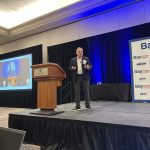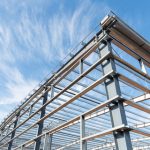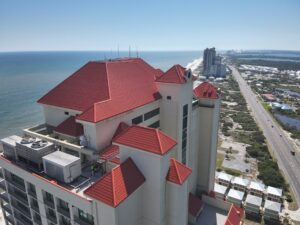
When thinking about metal roofing, many may envision a rusty old steel standing seam roof, perhaps even one their grandparents had on their farmhouse or barn. Metal roofing has come a long way since then, as it now comes in various metals, thicknesses, profiles, colors, textures, and finishes.
Today’s metal roofing offers many aesthetic choices, including profiles that mimic clay or concrete tile shake, slate, and even asphalt shingles. Print coats that make metal look like wood shakes, asphalt shingles, or other roofing materials are becoming more popular. Stone-coated metal panels are also available in many profiles, offering the appearance and texture of traditional roofing materials. Of course, standing seam panels are still available and remain a top choice for both residential and commercial roofs. Some benefits of these alternative metal roofing profiles include lighter weights than many of the traditional materials that they look like and extremely long life spans. They are also resistant to high winds, hail, and wildfire.
Many manufacturers make a variety of metal roofing profiles, including tiles, shakes, and shingles, in aluminum and steel. All can be provided with a 70 percent PVDF paint finish, along with other types of paint finishes. Some also come in anodized aluminum, copper, zinc, and stainless steel (depending on the profile).
Some metal roofing tiles look like traditional Spanish tiles, with a deep configuration in the form of an “S.” The panel is typically installed vertically up the roof’s slope on a solid substrate with exposed fasteners. This lightweight metal tile panel offers the look of a clay tile roof without the problems associated with its care.
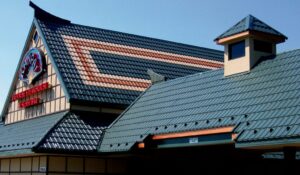
Another tile option is a scalloped tile with a Northern European flair, which is an easy-to-install metal roof panel. The panels are structural, practical, and unique, making them a great choice for steep-slope roof projects. They are the ideal roof system to stand up against storms, typhoons, hurricanes, damaging winds, and driving rains. The panel is installed horizontally, from eave to ridge. One lightweight profile has a 51-mm (2-in.) high integral Z purlin, allowing airflow between the panel and substrate.
There are many metal shingle profiles in the roofing market, including the dimensional panel, easily installed horizontally from eave to ridge with concealed fasteners. The metal shingle has pre-punched direct fastening points with a four-way interlock for weather tightness. These lightweight shingles are available in solid colors and print coats, which mimic asphalt shingles or slate patterns.
A diamond-shaped flat metal roof shingle offers a unique roof appearance. The shingle is easily installed from eave to ridge with concealed fasteners. An expanded polystyrene backer board allows for light foot traffic during installation, and different colors may be combined to create interesting patterns.
A shake-style profile, often called a Bermuda-style roof panel, is installed horizontally from eave to ridge with concealed fasteners and clips.
Shingles with standing seams simulate the look of a traditional standing seam roof but are manufactured in smaller lengths to make them easier to ship, handle, and install. They are elegant and feature a four-way interlock to ensure weather tightness. These panels are installed with concealed fasteners from eave to ridge and over a solid substrate. Transverse seams are staggered to provide a historic standing seam appearance. The metal roof allows snow and ice to slide off easily, preventing damage from freeze-thaw cycles.
In some cases, metal tiles, shingles, and shakes may be installed over an existing roof without tearing it off and disposing of it (subject to local codes). Typical applications are commercial or residential roofing; however, some profiles are suitable for wall applications and mansards.
Durable and resilient metal roofing is a sustainable choice due to the recycled content of the metal. The Metal Construction Association (MCA) states, “Metal roof and wall panels are made with the highest recycled content from the most recyclable materials on earth, making them a great choice not only for today but also for future generations to use.” The metal is also fully recyclable at the end of its long service life, meaning roofs do not need to be replaced as often, which keeps roofing materials out of landfills.
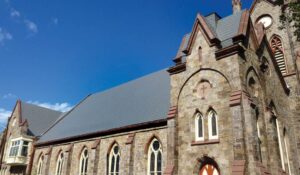
Cool pigment paints that reflect infrared radiation—available in most high-end paint systems on roofing panels—allow colors to resist chalking and fading while maintaining cooler surface temperatures. These coatings meet national energy standards and guidelines, and many comply with stringent California Title 24 Building Energy Efficiency Standards. Numerous LEED credits can be acquired depending on the roof’s solar reflectance index (SRI) and solar-ready capabilities.
Materials with cool pigment paints installed with above sheathing ventilation (ASV) can make buildings even more energy efficient. ASV creates energy savings by reducing air-conditioning costs in the summer and adding insulation value during the winter. This was proven by testing performance sponsored by the MCA at Oak Ridge National Laboratory. ASV also minimizes the effect of condensation between the roof layers.
Metal roofing is so much more than the old barn roofs of yesteryear. With today’s technologies and continuous product improvements, an investment in a metal roof will provide long-term protection for a home or building without sacrificing aesthetics.
Lee Ann Slattery is the sales support manager for ATAS International and the treasurer for the Metal Construction Association (MCA). She has 30 years of experience in sales and marketing within the architectural building products industry. She served as the Middle Atlantic Region Institute Director on the board of the Construction Specifications Institute (CSI) for four years and was elevated to Fellowship within CSI in 2020. She currently serves on the education committee for National Women in Roofing and is a director for the Lehigh Valley Let’s Build Construction Camp for Girls, founded in 2017. This year, she received a Lehigh Valley Women of Influence and a Circle of Excellence award from Lehigh Valley Business.



